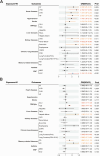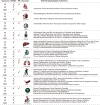Increased risk of chronic diseases and multimorbidity in middle-aged and elderly individuals with early vision, hearing, or dual sensory impairments: insights from prospective cohort studies and Mendelian randomization analysis
- PMID: 40001102
- PMCID: PMC11863693
- DOI: 10.1186/s12916-025-03857-x
Increased risk of chronic diseases and multimorbidity in middle-aged and elderly individuals with early vision, hearing, or dual sensory impairments: insights from prospective cohort studies and Mendelian randomization analysis
Abstract
Background: Sensory impairments (SI), including vision (VI), hearing (HI), and dual sensory impairments (DSI), are prevalent with aging, but their impact on disease risk remains unclear. This study investigates the epidemiological and genetic associations between SIs and 10 chronic disease categories and multimorbidity.
Methods: Using the CHARLS study, participants were classified by their self-reported VI/HI/DSI status in 2011 and 2013 into groups: "new onset, remission, persistent, and no SI." Their chronic disease incidence was tracked until 2018 in sub-cohorts respectively. Mendelian randomization (MR) analyses used genetic instruments from UK Biobank GWAS data on 88,250/504,307 individuals for vision/hearing loss, with outcome datasets from consortia including FinnGen, DIAMANTE, CKDGen, PGC, GWAS Catalog, and International Parkinson's Disease Genomics Consortium.
Results: The cohort study revealed that persistent HI significantly increased the risk of heart disease (P < 0.001, HR 1.63, 95% CI 1.31-2.03), stroke (P 0.004, HR 1.59, 95% CI 1.16-2.18), chronic lung disease (P 0.002, HR 1.53, 95% CI 1.17-1.99), and emotional, nervous, or psychiatric problems (P 0.016, HR 2.03, 95% CI 1.14-3.60). Persistent VI was significantly associated with diabetes or high blood sugar (DM/Hglu) (P 0.012, HR 1.63, 95% CI 1.11-2.38) and chronic lung disease (P 0.042, HR 1.53, 95% CI 1.02-2.31). MR confirmed these strong or suggestive associations, indicating that HI significantly increased the risk of cardiovascular and cerebrovascular events by 61-170%, bronchitis by 160%, and schizophrenia by 36%. In addition, VI significantly raised the risk of hyperglycemia or diabetes by 2-4% and the risk of lung function decline. Additionally, cohort studies confirmed that early DSI significantly raised the risk of multiple diseases, while MR identified genetic links between VI and hepatic failure, Parkinson's, and Alzheimer's disease, and between HI and hypertension, chronic kidney disease, and renal failure.
Conclusions: This study provides evidence from epidemiological or genetic perspectives demonstrates that early exposure to HI/VI/DSI increases the risk of developing chronic diseases. These findings underscore the need for continuous monitoring and timely intervention for SI to manage chronic disease risks in aging populations.
Keywords: Chronic diseases; Cohort study (CS); Dual sensory impairment (DSI); Hearing impairment (HI); Mendelian randomization analyses (MR); Multimorbidity; Vision impairment (VI).
© 2025. The Author(s).
Conflict of interest statement
Declarations. Ethics approval and consent to participate: CHARLS has received ethical approval from the Institutional Review Board of Peking University (Approved number: IRB00001052-11015), and all participants provided written informed consent. Consent for publication: All the listed authors have seen and approved the manuscript for publication. Competing interests: The authors declare no competing interests.
Figures





References
-
- GBD 2019 Blindness and Vision Impairment Collaborators; Vision Loss Expert Group of the Global Burden of Disease Study. Causes of blindness and vision impairment in 2020 and trends over 30 years, and prevalence of avoidable blindness in relation to VISION 2020: the Right to Sight: an analysis for the Global Burden of Disease Study [published correction appears in Lancet Glob Health. 2021 Apr;9(4):e408. 10.1016/S2214-109X(21)00050-4]. Lancet Glob Health. 2021;9(2):e144-e160. 10.1016/S2214-109X(20)30489-7. - PMC - PubMed
-
- Looi LM, Ganten D, McGrath PF, Gross M, Griffin GE. Hearing loss: a global health issue. Lancet. 2015;385(9972):943–4. 10.1016/S0140-6736(15)60208-2. - PubMed
MeSH terms
Grants and funding
LinkOut - more resources
Full Text Sources
Medical

